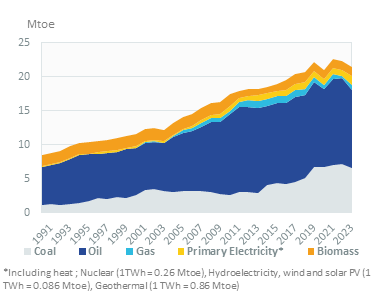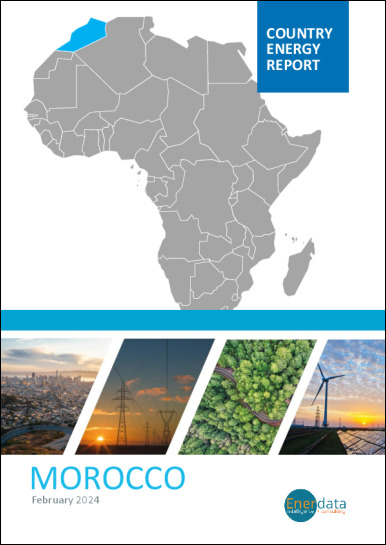- Update
-
- Format
- 3 files (PDF report, 2 Excel files)
- Pages
-
39 (Report only)
- Delivery
- Immediate by e-mail
- GENERAL OVERVIEW
- INSTITUTIONS AND ENERGY POLICY
- ENERGY SUPPLY
- ENERGY PRICES
- ENERGY CONSUMPTION
- ISSUES AND PROSPECTS
- DATA TABLES
- ABBREVIATIONS
- GLOSSARY
Buy Morocco energy report
Price without VAT. Depending on your statute and location, VAT might be applicable. Get in touch with us for more information.
After validation, you will immediately receive 3 files by email (one pdf report and 2 excel files containing the datasets).
Overview
This analysis includes a comprehensive Morocco energy market report and updated datasets. It is derived from the most recent key economic indicators, supply and demand factors, oil and gas pricing trends and major energy issues and developments surrounding the energy industry. The report provides a complete picture of the country situation, dynamics, current issues and future prospects. With market data and continuous follow-up of markets news, this report brings clear and concise insights with which to tackle national energy challenges and opportunities. Browse the tabs below for a detailed table of contents, the list of graphs and tables, and details on the data files.
Highlights
- Morocco has set an unconditional target of an 18.3% reduction in GHG emissions by 2030 and aims to achieve 80% of renewables in its power mix by 2050.
- ONEE operates more than half of the power capacity and the electricity transmission network. IPPs must sell their production to ONEE.
- Morocco is heavily dependent on imports.
- Thermal capacities reached 62% of the power mix (2022).
- Fuels and electricity prices in Morocco remained stable between 2022 and 2023.
- Fuel prices were completely deregulated in 2015.
- Oil accounts for nearly 58% of total energy consumption, while coal accounts for 32%.
- Electricity demand is expected to increase by 6%/year by 2030 to 80 TWh.
- Morocco has committed to a large number of renewable projects and is positioning itself as a pioneering African player in green hydrogen.
Institutions & Energy Policy
The Sustainable Ministry of Energy Transition and Sustainable Development (MTEDD) plays a central role in the implementation and coordination of the energy policy. It promotes the energy savings policy, as well as the development of new energies and renewables.
The Ministry of Economy and Finance is responsible for the taxation and financing of projects.
Energy Supply
Resources:
The country's fossil fuel resources are very limited (oil and gas reserves estimated at 0.1 Mt and at 1 bcm, respectively, at the end of 2022). However, renewable resources are important. The solar potential is high, with an average solar radiation of 6.5 kWh/m²/d (compared to 2.5 kWh/m²/d in Europe and 3.6 kWh/m²/d in the USA).
Energy Prices
Oil:
Until 2013, wholesale and retail margins were fixed by the government.
Energy Consumption
In 2022, per capita energy consumption was 0.60 toe (compared to 0.88 toe in Egypt, 1.49 toe in Algeria, and 0.94 toe in Tunisia), including around 965 kWh of electricity (34% below the North Africa average).
Graph: CONSUMPTION TRENDS BY ENERGY SOURCE (Mtoe)

Issues & Prospects
According to the MTEDD, the country's energy needs will more than triple by 2030. Morocco aims to cover 52% of capacity from renewables in 2030. In its new Low Carbon Development Strategy for 2050, Morocco aims to generate 70% of its electricity from renewables in 2040 and 80% in 2050.
- GRAPH 1: CO2-energy emissions (MtCO2)
- GRAPH 2: Installed electric capacity by source (2022 %)
- GRAPH 3: Gross power production by source (TWh)
- GRAPH 4: Power generation by source (2022, %)
- GRAPH 5: Gasoline & diesel prices (US$/l)
- GRAPH 6: Electricity prices for industry and households (US$c/kWh)
- GRAPH 7: Consumption trends by energy source (Mtoe)
- GRAPH 8: Total consumption market share by energy (2022, %)
- GRAPH 9: Final consumption market share by sector (2022, %)
- GRAPH 10: Oil consumption (Mt)
- GRAPH 11: Oil consumption breakdown by sector (2022, %)
- GRAPH 12: Electricity consumption (TWh)
- GRAPH 13: Electricity consumption breakdown by sector (2022, %)
- GRAPH 14: Natural gas consumption (bcm)
- GRAPH 15: Gas consumption breakdown by sector (2022, %)
- GRAPH 16: Coal consumption (Mt)
- GRAPH 17: Coal consumption breakdown by sector (2022, %)
- Economic Indicators: Annual historical data including population, GDP growth, imports and exports, inflation rate, energy security and efficiency indicators, CO2 emissions.
- Supply Indicators: Historical data including oil and gas reserves, electric and refining capacity, energy production, power production and external trade. All are detailed by energy source.
- Demand Indicators: Historical data including consumption per inhabitant, consumption trends, total consumption by energy source, final consumption by energy source and sector, and electricity consumption by sector.
- Energy Balances: Single table displaying the overall energy industry balance per annum, also graphically displayed by energy sub-segment.
- Infrastructure Projects: Covers power plant projects by energy, technology, status and operator, gas plant projects by status and operator and LNG contracts.
The Morocco energy market data since 1990 and up to
is included in the Excel file accompanying the Morocco country report.
It showcases the historical evolution, allowing users to easily work with the data.
Key Data included in the excelsheet:
- Economic indicators: Annual historical economic indicators, energy security, energy efficiency and CO2 emissions.
- Supply indicators: Annual historical reserves, capacity, production and external trade (imports(+) exports(-) balance).
- Demand indicators: Annual historical consumption per capita, consumption trends, total consumption, final consumption (per energy and per sector) and electricity consumption total and per sector.
- Energy Balance: total and per energy.
- Morocco Energy Prices: In addition to the analysis provided on the report we also provided a data set which includes historical details on the Morocco energy prices for the follow items: price of premium gasoline (taxes incl.), price of diesel (taxes incl.), price of electricity in industry (taxes incl.), price of electricity for households (taxes incl.), price of natural gas in industry (taxes incl.), prices of natural gas for households (taxes incl.), spot price of Brent and CO2 emissions (from fuel combustion).
 Energy and Climate Databases
Energy and Climate Databases Market Analysis
Market Analysis